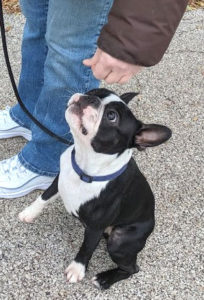Reward = communication

Your dog learns what’s “good” through the timing and placement of rewards. The dog’s reward lets him/her know to do it again. Rewards are your training currency.
That’s worth repeating. You are communicating with your dog not only with your words, but also with the timing and placement of the rewards you give.
Notice the placement of the reward for Simon (right). We’ll talk about that in a bit.
A dog’s reward can be other than food
It doesn’t matter what the dog’s reward is – treats, toys, petting. Your dog is getting information – “That was good! Do that some more! I liked that! What a brilliant puppy you are!” Fran’s giving Simon a tiny treat above – so she can give him lots!
Timing is critical, but it takes time
Timing is something you develop. You’ll get better and better at it over time. Clickers make timing easier – you can click right away and delay the actual reward. The clicker is also called a “bridge” for this reason – it’s a way of getting from the behavior to the reward, marking the “good,” even if there’s a delay in reward delivery.
Placing the reward is key
Placing the reward properly is something you can be good at right away. The rule is simple – always reward with the hand closest to the dog – like in the picture above.
It not only keeps things simple, it’s practical, and much safer for everyone.
Safety first!
Think about it: If your dog is on your left and the treat is in your right hand, your dog will cross in front of you to get the treat. And you’ll trip over your dog. Or kick your dog. It wouldn’t be good.
If you’re playing training games where your dog is in front of you, have treats in both hands. Then you can deliver the message “Good Dog!” randomly and not have your dog nuzzling at the “treat side.”
Reward for “Sit!”
If you’re teaching your dog the word for “sit,” reward high. When the dog’s head goes up, its butt tends to go down. It’s taking advantage of a dog’s natural behavior to play training games.
Reward for “Down!”
If you’re teaching your dog the word for “down,” reward between the front paws. If your dog has to reach for the treat, chances are he’ll get up. That’s not what we want.
Stay is different
If you’re playing “stay” games – reward where the dog is. Don’t have them reach or stretch in any way.
Remember – your dog learns these games through the timing and placement of rewards. Send the message clearly!
